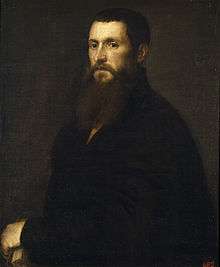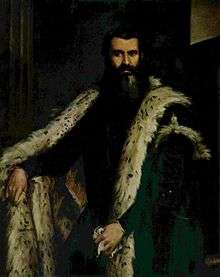Daniele Barbaro




Daniele Matteo Alvise Barbaro (also Barbarus) (8 February 1513 – 13 April 1570) was an Italian translator of, and commentator on, Vitruvius.[1] He also had a significant ecclesiastical career, reaching the rank of Cardinal.
He was born in Venice, the son of Francesco di Daniele Barbaro and Elena Pisani, daughter of the banker Alvise Pisani and Cecilia Giustinian.[2] Barbaro studied philosophy, mathematics, and optics at the University of Padua.[3] He has been credited with the design of the university's botanical garden.[4]
Barbaro served the Republic of Venice as ambassador to the court of Edward VI in London and as representative at the Council of Trent.[5] His appointment as Cardinal may have been secret (in pectore) to avoid causing diplomatic complications. In 1550 he was elected Patriarch of Aquileia,[6][7] an ecclesiastical appointment that required the approval of the Venetian Senate.
On the death of his father, he inherited a country estate with his brother Marcantonio Barbaro. They commissioned Palladio to design their shared country home Villa Barbaro, which is now part of a World Heritage Site.
Palladio and Daniele Barbaro visited Rome together and the architecture of the villa reflects their interest in the ancient buildings they saw there. The interior of the villa is decorated with frescoes by Paolo Veronese, who also painted oil portraits of Daniele; the one reproduced above on this article shows him dressed as a Venetian aristocrat, the one below shows him in clerical dress.[8]
Daniele Barbaro may have designed the Palazzo Trevisan in Murano, alone or in collaboration with Palladio. Like at the Villa Barbaro, Paolo Veronese and Alessandro Vittoria probably also worked on the project, which was completed in 1557.[9]
His will refers to his collection of purchased and constructed astronomical instruments.[10] Daniele renounced his inheritance in favor of his brother Marcantonio and was buried in an unmarked grave behind the Church of San Francesco della Vigna instead of the family chapel there.[11] Daniele commissioned the church's altarpiece of The Baptism of Christ (c.1555) by Battista Franco.[12]
Barbaro's fame is chiefly due to his vast output in the arts, letters, and mathematics. A cultured humanist, he was a friend and admirer of Torquato Tasso, a patron of Andrea Palladio,[13] and a student of Pietro Bembo.[14] Francesco Sansovino considered Daniele to be one of the three best Venetian architects, along with Palladio and his father Jacopo.
Works
His works include:
- (1542) ‘’Exquisitae in Porphyrium Commentationes’’.[15]
- (1542) ‘’Predica de' sogni’’, published under the pseudonym of Reverend padre Hypneo da Schio. .[16]
- (1544) Edited an edition of the commentaries on Aristotle's Rhetoric written. by his great-uncle Ermolao Barbaro.[17][18]
- (1545) Edited an edition of Ermolao Barbaro's Compendium scientiae naturalis.
- (1556) An Italian translation with extended commentary of Vitruvius' Ten Books of Architecture, published as Dieci libri dell'architettura di M. Vitruvio.[19][20] The work was dedicated to Cardinal Ippolito II d'Este, patron of the Villa d'Este at Tivoli.[21][22]
- (1567) He later published a Latin edition entitled M. Vitruvii de architectura. The original illustrations of Vitruvius' work have not survived, and Barbaro's illustrations were done specially by Andrea Palladio. As well as being important as a discussion of architecture, Barbaro's commentary was a contribution to the field of aesthetics in general. El Greco, for example, owned a copy. Earlier translations had been made, by Fra Giovanni and Como, but this work was considered the most accurate version to date. Barbaro clearly explained some of the more technical sections and discussed the relationship between nature and architecture, though he also acknowledged the way Palladio's theoretical and archeological expertise contributed to the work.[23][24]
- (1567) Dell Eloquenza Dialogo[25]
- (1568) La pratica della perspettiva, a book on perspective for artists and architects.[26][27] This work describes how to use a lens with a camera obscura.
- an unpublished and unfinished treatise on the construction of sundials (De Horologiis describendis libellus, Venice, Biblioteca Marciana, Cod. Lat. VIII, 42, 3097). The latter work was supposed to have discussed other instruments as well, including the astrolabe, the planisphere of Spanish mathematician Juan de Rojas, the navigation instrument cross-staff, the torquetum, an astronomical instrument and Abel Foullon's holometer, a surveying instrument.
See also
- Perfection (Aesthetic perfection)
- Portrait of Daniele Barbaro
- Barbaro family
Notes
- ↑ “The European Renaissance: centres and peripheries, Peter Burke, Blackwell Publishers Limited, 1998, pg.104 , ISBN 0-631-19845-8
- ↑ Venice and the Renaissance, Manfredo Tafuri, trans.Jessica Levine, 1989, MIT Press, ISBN 0-262-70054-9
- ↑ “A new general biographical dictionary, Volume 3”, Hugh James Rose, Henry John Rose, 1857, pg. 136 ISBN 0-333-76094-8
- ↑ “Encyclopedia of Italian Renaissance & Mannerist art, Volume 1”, Jane Turner, New York, 2000, pg. 113 ISBN 0-333-76094-8
- ↑ “A new general biographical dictionary, Volume 3”, Hugh James Rose, Henry John Rose, 1857, pg. 137 ISBN 0-333-76094-8
- ↑ “Renaissance education between religion and politics”, Paul F. Grendler, Aldershot: Ashgate,2006, pg. 72, ISBN 0-86078-989-6
- ↑ “A new general biographical dictionary, Volume 3”, Hugh James Rose, Henry John Rose, 1857, pg. 137 ISBN 0-333-76094-8
- ↑ There is a separate article on the portrait of Daniele Barbaro (1565-1567).
- ↑ “Encyclopedia of Italian Renaissance & Mannerist art, Volume 1”, Jane Turner, New York, 2000, pg. 113 ISBN 0-333-76094-8
- ↑ “Encyclopedia of Italian Renaissance & Mannerist art, Volume 1”, Jane Turner, New York, 2000, pg. 113 ISBN 0-333-76094-8
- ↑ “Encyclopedia of Italian Renaissance & Mannerist art, Volume 1”, Jane Turner, New York, 2000, pg. 113 ISBN 0-333-76094-8
- ↑ “Encyclopedia of Italian Renaissance & Mannerist art, Volume 1”, Jane Turner, New York, 2000, pg. 113 ISBN 0-333-76094-8
- ↑ “The European Renaissance: centres and peripheries, Peter Burke, Blackwell Publishers Limited, 1998, pg.155 , ISBN 0-631-19845-8
- ↑ “The European Renaissance: centres and peripheries, Peter Burke, Blackwell Publishers Limited, 1998, pg.104 , ISBN 0-631-19845-8
- ↑ “A new general biographical dictionary, Volume 3”, Hugh James Rose, Henry John Rose, 1857, pg. 137 ISBN 0-333-76094-8
- ↑ “A new general biographical dictionary, Volume 3”, Hugh James Rose, Henry John Rose, 1857, pg. 137 ISBN 0-333-76094-8
- ↑ “Encyclopedia of Italian Renaissance & Mannerist art, Volume 1”, Jane Turner, New York, 2000, pg. 112 ISBN 0-333-76094-8
- ↑ “A new general biographical dictionary, Volume 3”, Hugh James Rose, Henry John Rose, 1857, pg. 137 ISBN 0-333-76094-8
- ↑ “The European Renaissance: centres and peripheries, Peter Burke, Blackwell Publishers Limited, 1998, pg.104 , ISBN 0-631-19845-8
- ↑ “Renaissance education between religion and politics”, Paul F. Grendler, Aldershot: Ashgate,2006, pg. 72, ISBN 0-86078-989-6
- ↑ “Encyclopedia of Italian Renaissance & Mannerist art, Volume 1”, Jane Turner, New York, 2000, pg. 113 ISBN 0-333-76094-8
- ↑ “A new general biographical dictionary, Volume 3”, Hugh James Rose, Henry John Rose, 1857, pg. 137 ISBN 0-333-76094-8
- ↑ “Encyclopedia of Italian Renaissance & Mannerist art, Volume 1”, Jane Turner, New York, 2000, pg. 113 ISBN 0-333-76094-8
- ↑ “A new general biographical dictionary, Volume 3”, Hugh James Rose, Henry John Rose, 1857, pg. 137 ISBN 0-333-76094-8
- ↑ “A new general biographical dictionary, Volume 3”, Hugh James Rose, Henry John Rose, 1857, pg. 137 ISBN 0-333-76094-8
- ↑ “Encyclopedia of Italian Renaissance & Mannerist art, Volume 1”, Jane Turner, New York, 2000, pg. 113 ISBN 0-333-76094-8
- ↑ “A new general biographical dictionary, Volume 3”, Hugh James Rose, Henry John Rose, 1857, pg. 137 ISBN 0-333-76094-8
References
- Władysław Tatarkiewicz, History of Aesthetics, vol. III: Modern Aesthetics, edited by D. Petsch, translated from the Polish by Chester A. Kisiel and John F. Besemeres, The Hague, Mouton, 1974.